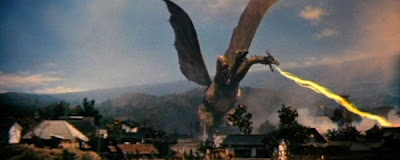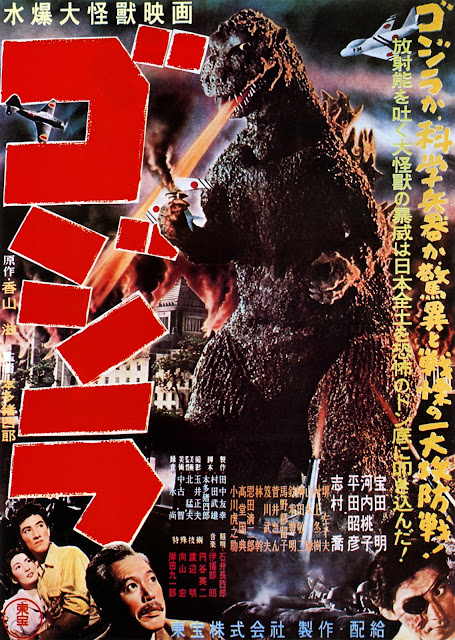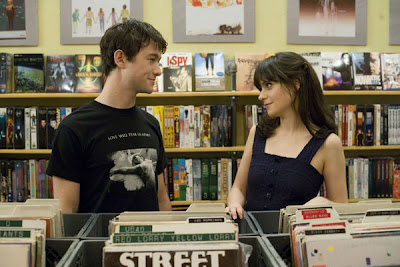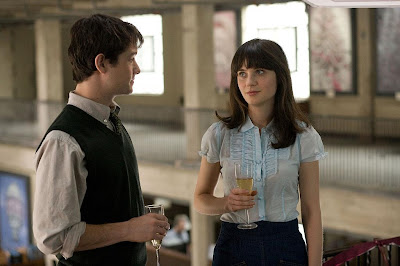Director: Ishiro Honda
Stars: Akihiko Hirata, Takashi Shimura
Genre: Giant Monster
Ghidorah, The Three-Headed Monster is one of the most praised films of the Showa era Godzilla series, likely because it introduces one of the franchise's most loved monsters: King Ghidorah. Made by many of the same minds behind the first Godzilla film, and many others that followed; Ishiro Honda directing, Akira Ifukube composing, produced by Tomoyuki Tanaka, and of course Eiji Tsuburaya in charge of the special effects.
All you really need to know about the plot (and indeed all I could follow) is that there is a new monster in town named King Ghidorah and the only way he can be stopped is if Godzilla and Rodan stop fighting and team up with Mothra to beat him (this is the first film that started portraying Godzilla as a hero rather than a villainous/indifferent monster). There's some other stuff involving the humans, like a Princess from Jupiter who can see into the future, but...well, well I really don't know what to say about all that.
The human characters are decent enough, and acted well, I guess. They're interesting enough to not bore you to death but the plot itself is extremely convoluted and, quite honestly, a tad irrelevant. You can pretty much accept the fact that for some reason or the other there are giant monsters and they are fighting each other. So I don't know if it's so much that the plot is hard to follow as it is just not worth following (perhaps a bit of both).
Ishiro Honda did a good job directing, and Eiji Tsuburaya's miniatures are certainly impressive, but that's not enough to save the film. What makes this film, in my opinion, absolute shit is the lackluster fight scenes. The fight scenes are a joke. The fight between Godzilla and Rodan is one of the most embarrassing things I've ever seen on film. They really go full retard here. The entire fight between Godzilla and Rodan is them wailing their rubber arms at each other, looking as if they're having multiple seizure or practicing some odd form of dance. It's like watching two retarded babies wrestle with blindfolds on. Not to mention that Godzilla's entire fighting style in this film, besides seizuring, pretty much consists completely of kicking/throwing rocks. I'm not even kidding, the amount of rocks thrown/kicked in this fight probably holds the record; at one point Godzilla and Rodan even start playing volleyball with a boulder. Godzilla doesn't even use his atomic breathe once! Then Mothra comes, but unfortunately Mothra never transforms into her winged form and she stays a caterpillar the entire time and just sprays white stuff on everyone. It's lame.
Of course the film is notable for being the debut of King Ghidorah, who is one of the cooler monsters in the franchise (despite his odd lack of arms), but he has certainly made better appearances later in the series. He's not quite as dumb as Godzilla and Rodan are in here, but he does a fair amount of seizure-dancing as well. And he pretty much just gives up and flies away after Mothra sprays some of that white stuff on him, so he's not exactly the badass he should have been.
I guess what is theoretically cool about this film is that instead of having only two monsters fight there is a big brawl with four monsters (which hadn't been done before), with Godzilla and Rodan and Mothra teaming up to defeat King Ghidorah. But, while this could have been potentially awesome (as later films in the franchise better showed us), it doesn't really matter how many monsters you throw in there when the fights are badly choreographed. It's just watching four retarded babies wrestle instead of two.
So while Honda's directing is good and Tsuburaya's modelwork is marvelous and Ifukube's score is stellar, none of it is enough to save the film from its ridiculously bad fight scenes and the convoluted plot. My favorite part of the damn movie was when the little fairies sang the Mothra song! I watched the original Japanese version of the film, not the English dub; I can only imagine how much worse the English version, as the Japanese versions of the Godzilla films are almost always preferable.
I can really not understand why so many people praise this film and why so many consider it to be one of the best (if not the best) of the Godzilla franchise. I'd call it one of the worst of the franchise (if not the worst), on par perhaps with the also infinitely shitty 1998 American Godzilla. Yes, it's that bad. For Godzilla completionists only.
Purchase Ghidorah, The Three-Headed Monster on Amazon: DVD - Stream - VHS
Stars: Akihiko Hirata, Takashi Shimura
Genre: Giant Monster
Ghidorah, The Three-Headed Monster is one of the most praised films of the Showa era Godzilla series, likely because it introduces one of the franchise's most loved monsters: King Ghidorah. Made by many of the same minds behind the first Godzilla film, and many others that followed; Ishiro Honda directing, Akira Ifukube composing, produced by Tomoyuki Tanaka, and of course Eiji Tsuburaya in charge of the special effects.
All you really need to know about the plot (and indeed all I could follow) is that there is a new monster in town named King Ghidorah and the only way he can be stopped is if Godzilla and Rodan stop fighting and team up with Mothra to beat him (this is the first film that started portraying Godzilla as a hero rather than a villainous/indifferent monster). There's some other stuff involving the humans, like a Princess from Jupiter who can see into the future, but...well, well I really don't know what to say about all that.
The human characters are decent enough, and acted well, I guess. They're interesting enough to not bore you to death but the plot itself is extremely convoluted and, quite honestly, a tad irrelevant. You can pretty much accept the fact that for some reason or the other there are giant monsters and they are fighting each other. So I don't know if it's so much that the plot is hard to follow as it is just not worth following (perhaps a bit of both).
Ishiro Honda did a good job directing, and Eiji Tsuburaya's miniatures are certainly impressive, but that's not enough to save the film. What makes this film, in my opinion, absolute shit is the lackluster fight scenes. The fight scenes are a joke. The fight between Godzilla and Rodan is one of the most embarrassing things I've ever seen on film. They really go full retard here. The entire fight between Godzilla and Rodan is them wailing their rubber arms at each other, looking as if they're having multiple seizure or practicing some odd form of dance. It's like watching two retarded babies wrestle with blindfolds on. Not to mention that Godzilla's entire fighting style in this film, besides seizuring, pretty much consists completely of kicking/throwing rocks. I'm not even kidding, the amount of rocks thrown/kicked in this fight probably holds the record; at one point Godzilla and Rodan even start playing volleyball with a boulder. Godzilla doesn't even use his atomic breathe once! Then Mothra comes, but unfortunately Mothra never transforms into her winged form and she stays a caterpillar the entire time and just sprays white stuff on everyone. It's lame.
Of course the film is notable for being the debut of King Ghidorah, who is one of the cooler monsters in the franchise (despite his odd lack of arms), but he has certainly made better appearances later in the series. He's not quite as dumb as Godzilla and Rodan are in here, but he does a fair amount of seizure-dancing as well. And he pretty much just gives up and flies away after Mothra sprays some of that white stuff on him, so he's not exactly the badass he should have been.
I guess what is theoretically cool about this film is that instead of having only two monsters fight there is a big brawl with four monsters (which hadn't been done before), with Godzilla and Rodan and Mothra teaming up to defeat King Ghidorah. But, while this could have been potentially awesome (as later films in the franchise better showed us), it doesn't really matter how many monsters you throw in there when the fights are badly choreographed. It's just watching four retarded babies wrestle instead of two.
So while Honda's directing is good and Tsuburaya's modelwork is marvelous and Ifukube's score is stellar, none of it is enough to save the film from its ridiculously bad fight scenes and the convoluted plot. My favorite part of the damn movie was when the little fairies sang the Mothra song! I watched the original Japanese version of the film, not the English dub; I can only imagine how much worse the English version, as the Japanese versions of the Godzilla films are almost always preferable.
I can really not understand why so many people praise this film and why so many consider it to be one of the best (if not the best) of the Godzilla franchise. I'd call it one of the worst of the franchise (if not the worst), on par perhaps with the also infinitely shitty 1998 American Godzilla. Yes, it's that bad. For Godzilla completionists only.
Purchase Ghidorah, The Three-Headed Monster on Amazon: DVD - Stream - VHS




































